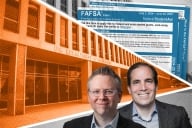You have /5 articles left.
Sign up for a free account or log in.
Son Kim Vo signed on to her radio show one Sunday late last month with a clear portrait of her audience -- engaged Vietnamese families -- and a clear goal: to spread her gospel about higher education.
During the 30-minute broadcast on Southern California’s KALI-FM, Vo described in Vietnamese (her native language) the difference between a community college and a university, explained how the SAT and ACT factor into admissions decisions, and introduced two new master’s programs at California State University at Fullerton, where she is coordinator of the intercultural development center.
Much of what Vo discussed on the radio program, the first in what she hopes to be a series on college issues, can be found in admissions guidebooks. But Vo wanted to reach the masses.
“The media is a very effective way to reach the Vietnamese community,” says Vo. “The Vietnamese listen to the radio all the time.”
They aren’t the demographic portrayed on any of the modish television shows set there, but Vietnamese are a major part of Orange County, Calif. The region is home to the largest Vietnamese population outside of Vietnam. Theirs is a highly concentrated group -- many work and live in the landlocked city of Garden Grove, where Vo broadcast the segment.
The city is also where officials at nearby Cal State Fullerton have concentrated much of their outreach efforts, as part of a Cal State systemwide effort to proactively recruit students in areas and in groups traditionally underserved by higher education.
Media campaigns are just one way colleges are targeting specific groups. Last fall, Cal State’s office of the chancellor sponsored a town hall discussion on issues facing Vietnamese Americans. The event was marketed to people of all ages and held at the Garden Grove Community Center, a magnet for Vietnamese families.
The event was part of the college’s effort to raise awareness among members of the community -- in particular influential civic, business and education leaders -- about resources available to them at Fullerton. For instance, the college sponsors a Vietnamese language and culture course for adult learners across the street from the community center.
“Our president said, ‘We’d like to be the campus that reaches out to the Vietnamese community,’ ” recalls Paula Selleck, a Fullerton spokeswoman. “We’re right in their backyard. We want to make it convenient for them.”
According to the U.S. Census Bureau’s 2005 data, Asians make up about 12 percent of California’s population. Cal State data from 2004 showed that 21 percent of students who identified their ethnicity said they were Asian, and 3 percent said they were Vietnamese. Asian American students are the second largest minority group, behind Hispanics, in the Cal State system. Many of the Cal State campuses have developed strategies for recruiting other Asian subgroups, including Chinese and Korean.
Still, there are many Asian students who are often overlooked in the recruiting process.
“The mission of a college is to create equal access,” says Tu Hoang, outreach counselor and program coordinator at Fullerton . “There are other groups [for whom] going to college might not be the first option.”
Hoang says Vietnamese students living in single-parent homes, those who don’t speak fluent English and those whose parents emigrated from rural Vietnamese communities are the most important targets, because they tend to be the least likely to consider college.
Jalani Bakari, assistant director of university outreach at Fullerton, says he has found that it’s just a matter of getting information to parents. “Students whose parents were doing lawn services were just as adamant about getting their kids into college,” he says.
When Bakari is speaking to Vietnamese students and their parents, he says, he likes to bring along a Vietnamese-American Fullerton student or alumnus and “let them become the communicator.”
“It’s really important to meet them in their language,” Bakari says. That’s why he turns to Hoang, a 2004 Fullerton graduate who speaks fluent Vietnamese.
As Selleck notes, some of a campus's success in attracting Vietnamese students can be attributed to its location: Staying close to home is important to many students, particularly those with tight-knit families.
Vo says many Vietnamese-Americans are particularly clustered at institutions like Fullerton, because they often live with relatives near the university. Fullerton had 2,042 Vietnamese students in the 2005-6 academic year, accounting for 17 percent of the student body.
Hyon Chu Yi-Baker, director of the Mosaic Crosscultural Center at San Jose State, said Filipino students, a prevalent ethnic group on her campus, are prone to staying close to home. “Like other Asian groups, the family plays a vital role in their lives,” she said.
But like the other Cal State colleges, Fullerton isn’t merely relying on nearby students coming to campus. Its recruitment campaign revolves around the idea that by reaching out to those who have an influence on potential students’ lives -- parents, older siblings, church leaders, teachers -- colleges are indirectly recruiting the students themselves.
Vo says she makes a special effort to espouse the importance of a college education to leaders in the Buddhist temple and Roman Catholic church, who hold significant power in the Orange County Vietnamese community, she says.
Fullerton’s town hall event featured a number of regional leaders, including the college’s president, a Vietnamese American state assemblyman, the founding director of the Vietnamese American Project at Fullerton and the president of the Vietnamese American Chamber of Commerce. Selleck says presenting leaders in the community is an effective recruiting tactic.
Vo, who serves on Fullerton’s Vietnamese task force that is charged with coming up with a list of best recruiting practices, is Fullerton's liaison between the college and the large Vietnamese speaking community.
There’s plenty for Vo to draw on when speaking about her experiences in higher education. After receiving her undergraduate degree in Vietnam, she attended Washington University in St. Louis and the University of Southern California for her master’s and Ph.D. degrees, respectively.
Finding the person to be your messenger is crucial in recruiting. Finding the most practical location to spread the message is equally important, says Jo Volkert, associate vice president of enrollment planning and management at San Francisco State University. While the community center made the most sense in Garden Grove, Volkert says the shopping mall was the best option in Daly City, a community south of San Francisco with a large Filipino population.
The mall is where San Francisco State holds a college fair each fall. The college is particularly interested in building on its population of Filipino students, who make up about 11 percent of the undergraduate student body and about 4 percent of the graduate population.
College officials market the event to high schools that have a high number of Filipino students. Like the Fullerton event, the family is the focus at the San Francisco State college fair. “We hold it at the mall because mom can check out the fair and little sister can go to Toys’R’us,” says Volkert. Anywhere from 20 to 30 colleges have booths at the fair, and Volkert said many of the institutions pack their booths with Filipino faculty or staff.
Nearly 18,000 Filipino students were in the Cal State system as of fall 2005. There are about 2,200 Filipino students at San Jose State. Forty-one percent of that campus is Asian-American.
Yi-Baker, the San Jose State director , said it is important also for colleges to highlight appropriate student groups and courses when wooing future students. For instance, San Jose State has a course on the Filipino American experience, in which the professor examines the history of the ethnic group and some contemporary issues facing its members. At San Francisco State, a campus support group called the Filipino-American Collegiate Endeavor is a selling point. On her radio show, Vo spoke about community service projects taken on by Vietnamese students at Fullerton.
Whatever the method, Volkert says that recruiting comes down to constant communication. “It’s about reaching out to friends and family," she says, "and getting them to feel an affinity for your institution."








